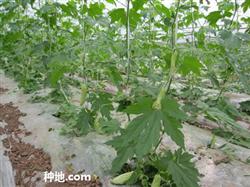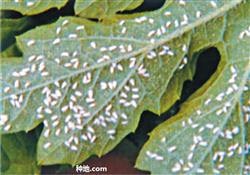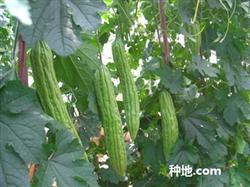How to cultivate balsam pear in open field?

How to cultivate balsam pear in open field? The scientific name of balsam pear is Momordica charantia L. Aliases are cool gourd, golden litchi and leprosy grape. It is a cultivated species of balsam pear of Cucurbitaceae and an annual climbing herb. It is native to subtropics and cultivated in South China, North China, Central China and Southwest China. Balsam pear eat more tender fruit, crisp and tender flesh, moderate bitterness, rich nutrition, increase appetite. It is not only rich in nutrition, but also has high medicinal value. Balsam pear has a bitter cold taste, clearing summer heat and relieving fever, clear vision and detoxification. Often eat balsam pear in summer, it has the effect of cooling blood and detoxification, and can prevent heatstroke, laryngitis, gastroenteritis, dermatitis and other diseases, so it is deeply loved by everyone. According to many years' cultivation experience, the cultivation techniques are introduced as follows. 1. Raising seedlings and cultivating strong seedlings is an important basis for the cultivation of balsam pear to obtain high yield and high quality. Balsam pear seed coat thick shell hard, direct sowing encountered low temperature overcast and rainy weather, easy to mildew rotten seeds, resulting in lack of seedlings and broken ridges in the field. Therefore, sprouting and sowing are generally adopted in production. Conventional budding methods often take 8 days to sprout. Here is a quick sprouting method. 1.1 before accelerating germination and soaking the seeds, dry the seeds for 5 hours, then soak the seeds in 54 ℃ lukewarm water for 10 minutes, stir constantly, and then soak the seeds in cold water for 10 hours. After the soaked seeds have been dried with a dry towel, break the seeds with pliers to facilitate budding, but do not damage the seeds. Then wrap the seeds in a wet towel and put them in an incubator. Under the condition of 30 ℃ 32 min, the seeds can sprout in about 36 hours. If there is no incubator, the following methods can be used: every 50 grams of seeds are sifted with 20 grams of furnace ash, the ash is mixed well with boiling water, the ratio of ash to boiling water is about 1Ru 0.7, hold into a ball, let go, then mix balsam pear seeds with hot coal ash and put them into a basin or other container. Cover it with straw and put it in a place with a heat source for budding. After 10 hours, the seeds in the basin will be changed up and down once, such as dry, can be evenly sprayed with 32 ℃ of warm water, continue to sprout, about 24 hours can sprout. 1.2 there are two sowing methods: separate seedling sowing and non-seedling sowing. In the separate seedling sowing method, firstly, the seedling site was arranged, the bottom water was poured, the water was seeped, a layer of dry soil was sprinkled, and then the seeds were sown on the seedling bed to avoid seed collision as far as possible, and then covered with fine dry soil 3-5cm, the temperature was kept at 30 ℃ and 35 mol, and the seedlings could emerge in about a week. When most of the seeds come out of the top soil, it is necessary to release the air in time, lift the film during the day, cover it at night, and divide the seedlings when the two cotyledons are flattened. Tidy up the seedling bed, plant the seedlings according to 10cm square and water them, and pay attention to keep a certain temperature. Non-seedling sowing method: that is, there is no seedling division after sowing, first, the germinated seeds are sown on the seedbed poured with sufficient bottom water according to 10cm square, and then cover with dry and fine soil to form a pile, each seed is a pile, and the soil pile is 3-5cm high, which is beneficial to expand the light and heat absorption area and promote seedling emergence. Then spread a layer of soil over the whole seedling bed. 1.3 Seedling stage management after sowing is mainly heat preservation and moisture preservation to promote seed germination, which should be kept at 30 ℃ during the day and not less than 13 ℃ at night. The film for heat preservation and moisture preservation should be tightly fastened, leaving no air vents, and strengthen the ability of moisturizing and cold protection. After emergence, the temperature can be lowered appropriately and the robust growth of seedlings can be promoted. Because balsam pear is a heat-resistant crop, it grows slowly in the seedling stage in spring, so the hours of light should be increased. The amount of air release can be increased one week before planting, until all the mulch is removed, and the stress resistance of seedlings can be strengthened so as to improve the adaptability of seedlings. For water management, in general, the seedling stage can no longer be watered, mainly rely on the bottom water of the seedling bed and adopt the method of covering soil to preserve soil moisture in order to maintain soil moisture. For example, when the soil is dry, it can cover wet soil, such as when the soil moisture is high, it can cover some fine dry soil, and if the soil is too dry, it can spray water properly, and the seedlings can be planted when they reach 4mur5 leaves. One week before planting, water is poured through, and stress resistance exercise is carried out at the same time to adapt to the external environment after planting. Second, it can be planted in North China after the late frost in early May. Balsam pear has developed root system, more lateral roots and high vine, which is suitable for cultivation on loose, fertile and convenient sandy loam soil. Apply sufficient base fertilizer before planting, and apply 1000-1500kg mature organic fertilizer per mu. When planting with soil, the general row spacing is 0.8m, the plant spacing is 0.5m, and there are 1600-1800 seedlings per mu, which can be planted by the method of plastic film covering small high border or ditching seedlings with dark water. 3. Proper topdressing after planting and strengthening mid-tillage to promote growth and development are the key measures for seedling management, early harvest and high yield after planting. In North China, in the early stage of seedling growth, if the soil is dry, the symptoms of virus disease are easy to appear, the plant growth is stagnant, and the seedlings are small and do not grow, water and fertilizer should be strengthened to promote melon vines on shelves and ridges as soon as possible. 1.1 Fertilizer and water management: plant water should be watered immediately after planting, slow seedling water should be watered one week after planting, then squatting seedlings should be ploughed in about 10 days, top dressing with water should promote growth, and water should be watered every 6 seconds and 7 days thereafter. Squatting seedlings properly during the flowering period, ploughing to preserve soil moisture, and then watering to promote seedlings after the first melon seat is settled. During the full fruiting period, it is appropriate to irrigate 5Mel once every 7 days. Balsam pear seedling stage is not tolerant to fertilizer, topdressing should be applied thinly. Melon should be fertilized continuously after the beginning, combined with watering, topdressing every 15 days, each mu topdressing urea 10kg or compound fertilizer 15-20kg. Results in order to prevent premature senescence and prolong the harvest time, 2 Mel superphosphate should be applied 3 times and 10-20kg each time. If the topdressing is insufficient in the full fruit stage, the plant growth is weak, the lateral branches are thin, the leaves are yellow, the melons are few, the melons are small, the yield is low, the quality becomes worse, and the bitterness increases. 1.2 erection and pruning: balsam pear vines are slender and should be tied up in time to avoid damage due to strong wind. Because the female flowers of balsam pear lateral vines occur late, the basal lateral vines should be removed to give full play to the advantages of the main vines. Otherwise, the vigorous growth of lateral vines will not only waste the nutrients of the plant, but also lead to crazy growth, resulting in melon, premature senility and so on. In general, when the main vine grows to 50-70cm, it begins to trim the vine, removing all the lateral vines at the base, leaving only the main vine on the shelf. After the main vine is on the shelf, if the side vine does not have a female flower, remove the side vine from the base. If there are female flowers, you should pick the heart to protect the melon in time. In the later stage of growth, old leaves, diseased leaves, yellow leaves and small lateral branches should be removed in time for ventilation and light transmission. Fourth, the harvest balsam pear is to tender fruit (melon) for consumption, in the production should be harvested in time. Generally, the harvest time is 15 days after flowering, and the performance characters that can be harvested are as follows: the strip or verrucous protuberance of the fruit is full, the color of the top of the fruit becomes lighter, the Corolla is dry and shedding, and the pericarp is shiny. Balsam pear seeds develop rapidly, fruit physiological maturity is also rapid, if harvested too late, the top of the melon becomes yellow or orange, the bitter taste becomes light, the meat becomes soft, and the quality decreases; if harvested too early, the melon strips do not fully grow up, bitter taste is strong, the quality is poor, and the yield is low. It is best to cut it from the base of the stalk with scissors during harvest so as not to tear the plant or leaf when picking by hand. Click to get more balsam pear planting techniques click to get more vegetable planting techniques
- Prev

How to control whitefly in greenhouse balsam pear?
How to control whitefly in greenhouse balsam pear? Greenhouse whitefly, also known as greenhouse whitefly, belongs to Homoptera, whitefly family. In the late 1970s, with the expansion of greenhouse, plastic greenhouse and other protected vegetables, the occurrence and distribution of this insect showed an expanding trend. At present, it has occurred and damaged in most parts of our country.
- Next

How to plant balsam pear efficiently?
How to plant balsam pear efficiently? Please guide balsam pear, also known as cold gourd, is a cucurbitaceae vegetable plant, like high temperature, more heat-resistant, not cold-resistant, can be planted in our county all the year round. In recent years, with the continuous adjustment and optimization of crop structure and the continuous development and demand of melon and vegetable consumption market, balsam pear has become our county's northward transportation and export.
Related
- Where is it suitable to grow horseradish in China? it is expected to see the middle altitude horseradish in Alishan.
- How to prevent tomato virus disease reasonably? (Control methods included)
- Many people like to plant towel gourd on the balcony. What are the main points of this method and management?
- What crops can chili peppers be mixed with?
- Fertilization techniques and matters needing attention in Tomato
- What are the grafting techniques for peach seedlings in spring?
- Harm and control methods of root swelling disease of Chinese cabbage
- What are the pests of sweet potatoes? How to prevent and cure it?
- Symptoms, causes and Control methods of navel Rot in Tomato
- The cause of "Cucumber rotten bibcock" in Farmers' planting Cucumber and its Control Plan

